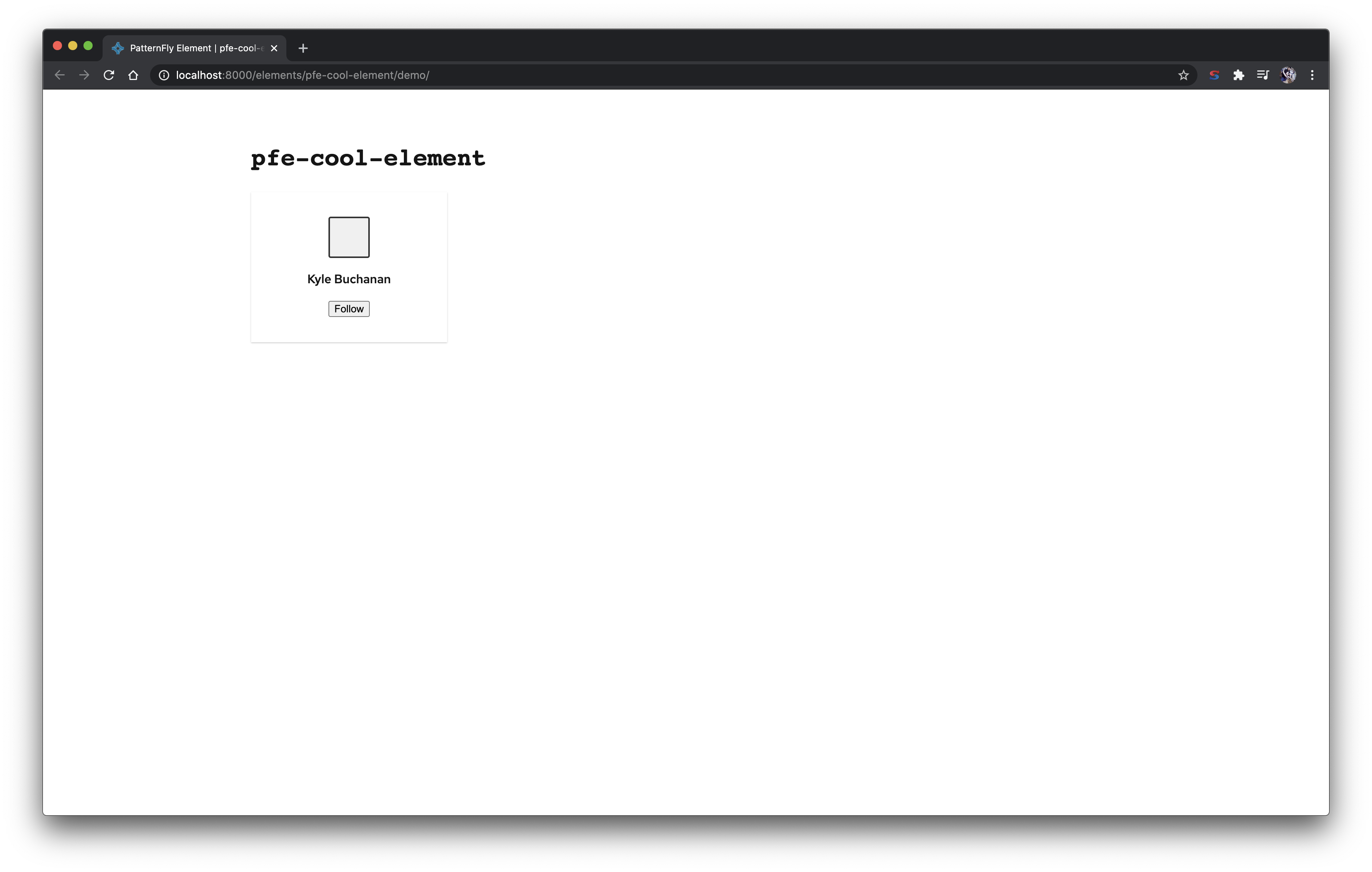Write your Sass
We want the pfe-cool-element to have a profile photo, a username, and a follow button.
Right now, it only contains the HTML structure, but we can style our element by updating our Scss (or CSS) to make it look the way we want.
We'll be working in the pfe-cool-element.scss file since we decided to use the Sass option in the PatternFly Element generator.
Your SASS file will initially contain a @use statement, and a configure mixin call from the pfe-sass node module, but we can ignore that for now.
The second part has a :host selector that makes our element display as a block element.
@use "@patternfly/pfe-sass" as *;
@include configure(
$name: 'cool-element',
$variables: (),
);
:host {
display: block;
}When structuring your scss, some general rules for organization are:
- Define your hooks and their default values at the top of the file, inside the configure call.
- Apply the hooks to the appropriate properties
- Modifiers should update local variables
- this will override any variables set externally - attributes are always stronger than variable overrides
@include configure(
$name: 'cool-element',
$variables: (
Property: default-value,
region: (
Property: default-value
),
),
);
:host {
property: pfe-local(Property);
}
:host([modifiers]) {
$modifier: ( Property: updated-value );
@include pfe-print-local($modifier); // outputs: --pfe-cool-element--Property: updated-value;
}
// Light DOM styles
::slotted(*) {
> typography defaults
}
// Class-based shadow DOM styles
.pfe-cool-element {
&__region {
// Apply the hooks to the appropriate properties in their regions too
property: pfe-local(Property, $region: region);
// 1. default styles
// 2. media queries
&[modifiers] {
--pfe-cool-element__region--Property: updated;
}
}
// Modifiers can also be set using classes and scoped to the Shadow DOM
&--modifier {
--pfe-cool-element--Property: updated;
}
}Now we can update our styles, like so:
@include configure(
$name: 'cool-element',
$variables: (
Width: 128px,
Padding: calc(#{pfe-var(container-spacer)} * 2),
profile: (
BackgroundColor: pfe-var(surface--base),
context: pfe-var(surface--base--context),
Border: 2px solid #333,
),
),
);
:host {
// Hardcoded, not connected to theme
display: flex;
flex-direction: column;
align-items: center;
justify-content: center;
// Local variable hooks
width: pfe-local(Width);
padding: pfe-local(Padding);
// Global theme variable hooks only
font-family: pfe-var(font-family);
box-shadow: pfe-var(box-shadow--sm);
}
:host([hidden]) {
display: none;
}
.pfe-cool-element {
&__profile {
background-color: pfe-local(BackgroundColor, $region: profile);
// Any time background color is updated, context should be set too
// This sets the `on=` attribute on the component
--context: #{pfe-local(context, $region: profile)};
// The above mixins outputs:
// :host([on="dark"]) {
// --pfe-broadcasted--text: var(--pfe-theme--color--text--on-dark, #fff);
// --pfe-broadcasted--link: var(--pfe-theme--color--link--on-dark, #99ccff);
// --pfe-broadcasted--link--hover: var(--pfe-theme--color--link--hover--on-dark, #cce6ff);
// --pfe-broadcasted--link--focus: var(--pfe-theme--color--link--focus--on-dark, #cce6ff);
// --pfe-broadcasted--link--visited: var(--pfe-theme--color--link--visited--on-dark, #b38cd9);
// --pfe-broadcasted--link-decoration: none;
// --pfe-broadcasted--link-decoration--hover: underline;
// --pfe-broadcasted--link-decoration--focus: underline;
// --pfe-broadcasted--link-decoration--visited: none;
// }
border: pfe-local(Border, $region: profile);
border-radius: pfe-var(surface--border-radius);
// Hardcoded values
width: 50px;
height: 50px;
margin-bottom: 16px;
}
&__social--follow {
margin-top: 16px;
}
}After saving and viewing our demo page, our profile element looks much better.

A couple of things to note:
- The
:hostselector sets the styles of the container element<pfe-cool-element>. - The
buttonstyles are encapsulated within this element and will not bleed out, meaning that there's no chance these styles will affect other buttons on the page. Feeling confident that your element will always look the same when it's distributed is one of the main advantages of the shadow DOM. Check out the Styling section of Shadow DOM v1: Self-Contained Web Components to learn what else you can do when applying styles to the shadow DOM.
Now that our pfe-cool-element is more appealing, we'll add the follow button's interaction
and fill in the profile photo.
We can accomplish both of these tasks by updating the pfe-cool-element.ts file.
Learn more about applying a theme.